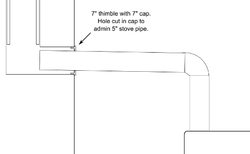Hi. I have an unused flue in my basement. It was previously for the oil boiler but we have removed the boiler entirely (now have PVC vented gas boiler elsewhere). I had the flue swept and I want to attach a wood stove to the unused flue. The flue is part of a masonry chimney with 8.5" square clay liner up to the top. The thimble for the oil boiler is in the concrete foundation of the house and penetrates into the brick chimney.
The thimble for the oil boiler was 7" and the collar/stove pipe for the wood stove are 5". I am planning to cut a 5" hole in a 7" cap so that I can pass the 5" stove pipe into the unused flue. I attached a diagram that shows what I'm planning.
Questions:
* Is there a better way to insert the 5" stove pipe into the 7" thimble? I couldn't find any adapters that seemed to be a better fit.
* How far past the thimble opening should the stove pipe go? A mason advised running it to the edge of the clay liner, so that's what I'm planning to do. But, just to confirm, does the diagram look reasonable?
Thanks for your help!

The thimble for the oil boiler was 7" and the collar/stove pipe for the wood stove are 5". I am planning to cut a 5" hole in a 7" cap so that I can pass the 5" stove pipe into the unused flue. I attached a diagram that shows what I'm planning.
Questions:
* Is there a better way to insert the 5" stove pipe into the 7" thimble? I couldn't find any adapters that seemed to be a better fit.
* How far past the thimble opening should the stove pipe go? A mason advised running it to the edge of the clay liner, so that's what I'm planning to do. But, just to confirm, does the diagram look reasonable?
Thanks for your help!


